Sistine Chapel
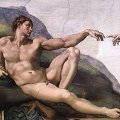 The Sistine Chapel (Cappella Sistina) is a chapel in
the Apostolic Palace, the official residence of the Pope, in the
Vatican City. Its fame rests on its architecture, which evokes the
Temple of the Old Testament, and its decoration, frescoed throughout
by the greatest Renaissance artists, including Michelangelo, whose ceiling is legendary. The Sistine Chapel is
considered to be the greatest artistic creation in the history
of mankind. Michelangelo could possibly be the greatest artist who has
ever lived. His paintings in Sistine Chapel, the triumph of
Renaissance humanist ideal, have changed the meaning of art
forever.
The Sistine Chapel (Cappella Sistina) is a chapel in
the Apostolic Palace, the official residence of the Pope, in the
Vatican City. Its fame rests on its architecture, which evokes the
Temple of the Old Testament, and its decoration, frescoed throughout
by the greatest Renaissance artists, including Michelangelo, whose ceiling is legendary. The Sistine Chapel is
considered to be the greatest artistic creation in the history
of mankind. Michelangelo could possibly be the greatest artist who has
ever lived. His paintings in Sistine Chapel, the triumph of
Renaissance humanist ideal, have changed the meaning of art
forever.
Five Sibyls
The sibyls are prophetic women who were resident at shrines or temples throughout the Classical World. The five depicted here are each said to have prophesied the birth of Christ. Three of the sibyls (Libyan, Cumaean and Delphican) are on one side, separated by the prophets Daniel and Isaiah. The remaining sibyls (Erythraean and Persian) are on the other side, with the prophet Ezechiel between them.
- Sistine Chapel, Five Sibyls, The Delphic Sibyl (1509)
- Sistine Chapel, Five Sibyls, The Delphic Sibyl (Detail) (1509)
- Sistine Chapel, Five Sibyls, The Erythraean Sibyl (Detail) (1509)
- Sistine Chapel, Five Sibyls, The Cumaean Sibyl (1510)
- Sistine Chapel, Five Sibyls, The Cumaean Sibyl (Detail) (1510)
- Sistine Chapel, Five Sibyls, The Libyan Sibyl (1511)
- Sistine Chapel, Five Sibyls, The Libyan Sibyl (Detail) (1511)
- Sistine Chapel, Five Sibyls, The Persian Sibyl (1511)
Sistine Chapel, Five Sibyls, The Delphic Sibyl (1509)
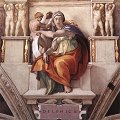 Get
Get  a high-quality picture of
Sistine Chapel, Five Sibyls, The Delphic Sibyl for your computer or notebook. ‣
Unwinding a scroll with her left hand, the Delphic Sibyl seems to
be turning toward the viewer. The effect of movement is accentuated by
the swirls of the light blue mantle lined with yellow fabric with red
shadows and the pattern of the folds of the light green tunic. The
very refined colours are characterized by delicate tonal passages and
enamel-like surfaces.
a high-quality picture of
Sistine Chapel, Five Sibyls, The Delphic Sibyl for your computer or notebook. ‣
Unwinding a scroll with her left hand, the Delphic Sibyl seems to
be turning toward the viewer. The effect of movement is accentuated by
the swirls of the light blue mantle lined with yellow fabric with red
shadows and the pattern of the folds of the light green tunic. The
very refined colours are characterized by delicate tonal passages and
enamel-like surfaces.
The unique female figures and representations of the eternal mother are overwhelming. Of course, the Sibyls differ vastly from the Prophets, for Michelangelo remained mindful of the saying 'mulier taceat in ecclesia'. With the exception of the Pythia of Delphi, they are not conceived as priestesses. It is that which is beautiful and most characteristic, in short, their essentially feminine quality, that is brought out. As a group, including not only the three beautiful young women but the others too, they represent the Renaissance ideal of the virago, in the original sense of the word; a woman physically and mentally heroic. One must imagine these Sibyls free of male bondage, chiefly because their male aspect, existing side by side with the female - for they are not masculine women - is very much in evidence in the form of strength and power. This, admittedly, applies least of all to the Pythia of Delpbi who shines with a priestly and inspired radiance, which does not prevent this pagan servant of Apollo from being a young and enchanting girl.
The Delphic virgin is coifed with a white priestly band beneath a peacock blue headdress draped like a crown or diadem; she gives true oracles and lives on in the great Holy Virgins of Christian art, who often wear a sibylline expression. The left arm bent over the open scroll is prefigured in the 'Madonna Doni', the fair hair is blown back by the wind of the spirit.
Sistine Chapel, Five Sibyls, The Delphic Sibyl (Detail) (1509)
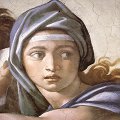 Get
Get  a high-quality picture of
Sistine Chapel, Five Sibyls, The Delphic Sibyl (Detail) for your computer or notebook. ‣
In the center of the face - seen frontally, half in the light and
half in a moderate shadow - there are traces of a crossincised to mark
the vertical axis of the oval and the alignment of the eyes.
a high-quality picture of
Sistine Chapel, Five Sibyls, The Delphic Sibyl (Detail) for your computer or notebook. ‣
In the center of the face - seen frontally, half in the light and
half in a moderate shadow - there are traces of a crossincised to mark
the vertical axis of the oval and the alignment of the eyes.
Sistine Chapel, Five Sibyls, The Erythraean Sibyl (Detail) (1509)
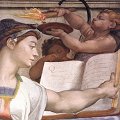 Get
Get  a high-quality picture of
Sistine Chapel, Five Sibyls, The Erythraean Sibyl (Detail) for your computer or notebook. ‣
Turning to leaf through the large book on the lectern, the sibyl is
wearing a white tunic with greenish reflections under a red bodice.
The orange mantle lined with green is folded over her legs. Behind the
lectern, one of the two small boys lights a lamp, while the other rubs
his eyes, as if he has just woken up.
a high-quality picture of
Sistine Chapel, Five Sibyls, The Erythraean Sibyl (Detail) for your computer or notebook. ‣
Turning to leaf through the large book on the lectern, the sibyl is
wearing a white tunic with greenish reflections under a red bodice.
The orange mantle lined with green is folded over her legs. Behind the
lectern, one of the two small boys lights a lamp, while the other rubs
his eyes, as if he has just woken up.
Sistine Chapel, Five Sibyls, The Cumaean Sibyl (1510)
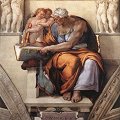 Get
Get  a high-quality picture of
Sistine Chapel, Five Sibyls, The Cumaean Sibyl for your computer or notebook. ‣
The Cumaean Sibyl oppresses by the sheer weight of her bulk and a
commanding ugliness. With the open folio bound in green and her two
genii gazing at its pages over her shoulders she has become one of the
Fates, a towering shape with human features. Whenever Sibyls are
mentioned, the Cumaea at once comes to mind. In the art of
Michelangelo and other painters her powerful presence overshadows
every other Sibyl, even her younger and more beautiful sisters, such
as the Delphica.
a high-quality picture of
Sistine Chapel, Five Sibyls, The Cumaean Sibyl for your computer or notebook. ‣
The Cumaean Sibyl oppresses by the sheer weight of her bulk and a
commanding ugliness. With the open folio bound in green and her two
genii gazing at its pages over her shoulders she has become one of the
Fates, a towering shape with human features. Whenever Sibyls are
mentioned, the Cumaea at once comes to mind. In the art of
Michelangelo and other painters her powerful presence overshadows
every other Sibyl, even her younger and more beautiful sisters, such
as the Delphica.
Sistine Chapel, Five Sibyls, The Cumaean Sibyl (Detail) (1510)
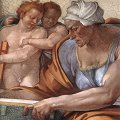 Get
Get  a high-quality picture of
Sistine Chapel, Five Sibyls, The Cumaean Sibyl (Detail) for your computer or notebook. ‣
The Cumaean Sibyl is depicted as a massively built old woman, with
a dark complexion and a wrinkled face, completely absorbed in the
difficult task of ddecipheriong the meaning of what she is reading in
the large book, which rests next to her on the side of the marble
throne.
a high-quality picture of
Sistine Chapel, Five Sibyls, The Cumaean Sibyl (Detail) for your computer or notebook. ‣
The Cumaean Sibyl is depicted as a massively built old woman, with
a dark complexion and a wrinkled face, completely absorbed in the
difficult task of ddecipheriong the meaning of what she is reading in
the large book, which rests next to her on the side of the marble
throne.
Sistine Chapel, Five Sibyls, The Libyan Sibyl (1511)
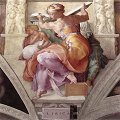 Get
Get  a high-quality picture of
Sistine Chapel, Five Sibyls, The Libyan Sibyl for your computer or notebook. ‣
The Libica, or Libyan Sibyl brings pre-Christian prophecy to a
close. With a graceful movement, displaying her lovely shoulders, her
foreshortened arms, and the lowered profile of her fine head with its
gold tresses, she lays aside the open book as if about to close it. It
is a large and cumbersome volume which might well contain all former
prophecies. The splendid and superbly gowned figure is extremely
colourful; gold tints prevail in her dress lined with salmon pink: the
gold of wisdom, the only certain kind of knowledge. Here as elsewhere,
one marvels at the extraordinary effects obtained with the cold, flat
technique of alfresco painting, which had none of the advantages and
material possibilities of oil. This figure is that of a noble lady
rather than a prophetess, the opposite and counterpart of the gloomy
Jeremiah. A faint smile lightens her otherwise remote air.
a high-quality picture of
Sistine Chapel, Five Sibyls, The Libyan Sibyl for your computer or notebook. ‣
The Libica, or Libyan Sibyl brings pre-Christian prophecy to a
close. With a graceful movement, displaying her lovely shoulders, her
foreshortened arms, and the lowered profile of her fine head with its
gold tresses, she lays aside the open book as if about to close it. It
is a large and cumbersome volume which might well contain all former
prophecies. The splendid and superbly gowned figure is extremely
colourful; gold tints prevail in her dress lined with salmon pink: the
gold of wisdom, the only certain kind of knowledge. Here as elsewhere,
one marvels at the extraordinary effects obtained with the cold, flat
technique of alfresco painting, which had none of the advantages and
material possibilities of oil. This figure is that of a noble lady
rather than a prophetess, the opposite and counterpart of the gloomy
Jeremiah. A faint smile lightens her otherwise remote air.
Sistine Chapel, Five Sibyls, The Libyan Sibyl (Detail) (1511)
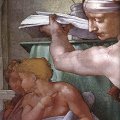 Get
Get  a high-quality picture of
Sistine Chapel, Five Sibyls, The Libyan Sibyl (Detail) for your computer or notebook. ‣
The complex, almost serpentine, rotation of the young sibyl, who
seems to be rising from hrer seat, gives prominence to the remarkable
richness, elegance, and delicacy of the juxtapositions of colour.
Thus, the light violet of the ribbon tied around the sibyl's head is
placed next to the yellow ochre of the braid; the deeper, brighter
yellow of the bodice, bordered with gray-blue and open at the sides,
is next to the red ochre of the lining and the light violet of the
robe, which resembles that of the ribbon.
a high-quality picture of
Sistine Chapel, Five Sibyls, The Libyan Sibyl (Detail) for your computer or notebook. ‣
The complex, almost serpentine, rotation of the young sibyl, who
seems to be rising from hrer seat, gives prominence to the remarkable
richness, elegance, and delicacy of the juxtapositions of colour.
Thus, the light violet of the ribbon tied around the sibyl's head is
placed next to the yellow ochre of the braid; the deeper, brighter
yellow of the bodice, bordered with gray-blue and open at the sides,
is next to the red ochre of the lining and the light violet of the
robe, which resembles that of the ribbon.
Sistine Chapel, Five Sibyls, The Persian Sibyl (1511)
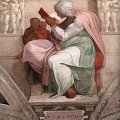 Get
Get  a high-quality picture of
Sistine Chapel, Five Sibyls, The Persian Sibyl for your computer or notebook. ‣
Primordial, totally detached, her eyes focused on things outside
this world, and she herself almost a cave of mystery - such is the
Persica of the Sistine Chapel. Something of Leonardo's chiaroscuro has
crept into her composition. She is a presence still more powerful and
secretive, magical and abstracted than the Cumaean Sibyl.
a high-quality picture of
Sistine Chapel, Five Sibyls, The Persian Sibyl for your computer or notebook. ‣
Primordial, totally detached, her eyes focused on things outside
this world, and she herself almost a cave of mystery - such is the
Persica of the Sistine Chapel. Something of Leonardo's chiaroscuro has
crept into her composition. She is a presence still more powerful and
secretive, magical and abstracted than the Cumaean Sibyl.
Michelangelo Art
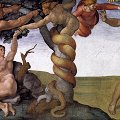
|
|
More
Articles
 Art Encyclopedia A world history of art in articles.
Art Encyclopedia A world history of art in articles.
Renaissance
Michelangelo
Art, life and biography.
Michelangelo's David.
Michelangelo's Pieta.
Sistine Chapel. High Renaissance Masterpiece.
Sistine Chapel. Book of Genesis.
Sistine Chapel. The Ignudi.
Sistine Chapel. Seven Prophets.
Sistine Chapel. Five Sibyls.
Sistine Chapel. Lunettes.
Sistine Chapel. Pendentives.
Sistine Chapel. The Ancestors of Christ.
Sistine Chapel. The Last Judgement.
Art
 Art Wallpapers Art image collections for your desktop.
Art Wallpapers Art image collections for your desktop.
Della Francesca Art, $19
(95 pictures)
Da Vinci Art, $25
(80 pictures)
Michelangelo Art, $29
(180 pictures)
Raphael Art, $25
(125 pictures)
Titian Art, $29
(175 pictures)
Durer Art, $25
(120 pictures)

